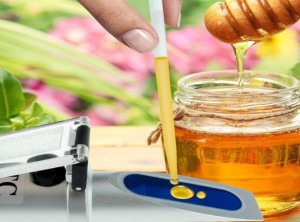
The Crucial Role of Moisture and Electrical Conductivity Tests in Ensuring Honey Quality
Introduction:
Honey, a golden elixir produced by bees, has captivated human taste buds for centuries. It is often referred to as nature's sweet treasure, has been a staple in human diets for centuries due to its unique flavors, nutritional benefits, and therapeutic properties which makes it a sought-after natural sweetener. As the demand for high-quality honey continues to grow, ensuring the purity and authenticity of honey products becomes paramount. Among the various tests conducted on honey samples, moisture content and electrical conductivity tests stand out as crucial parameters for evaluating and guaranteeing honey quality and assuring product quality is of utmost importance. This essay explores the pivotal roles these tests play in maintaining the integrity of honey and meeting consumer expectations.
Moisture Content in Honey:
Moisture content is a critical parameter in assessing honey quality, as it directly influences the product's stability, taste, and shelf life. Moisture in honey is measured using refractrometer based on its refractive index the moisture is estimated. The optimal moisture content in honey typically ranges between 14% and 18%, and deviations from this range can have significant implications.
1. Preventing Fermentation:
The moisture content in honey is a pivotal parameter that significantly influences its stability and quality. Honey is hygroscopic, meaning it readily absorbs moisture from the environment. An optimal moisture content, typically ranging between 14% and 18%, is essential for preventing fermentation. High moisture levels create a favorable environment for the growth of microorganisms, leading to fermentation, which alters the taste, aroma, and texture of honey. By conducting moisture tests, beekeepers and honey processors can identify batches prone to fermentation, allowing for timely interventions to preserve the quality of the honey.
2. Ensuring Storage Stability:
The ideal moisture content in honey contributes to its storage stability. Low moisture levels inhibit the growth of yeast and bacteria, thereby extending the shelf life of honey. Monitoring and maintaining the appropriate moisture content through rigorous testing protocols ensure that honey products retain their quality and safety during storage. This is crucial not only for meeting consumer expectations but also for preventing economic losses due to spoilage.
3. Preventing Adulteration:
Adulteration of honey with added water or other substances is a prevalent issue in the industry. Adulterated honey not only compromises its nutritional value but also undermines consumer trust. Moisture testing serves as a reliable method for detecting adulteration. By adhering to established moisture content standards, producers can verify the authenticity of their honey, protecting consumers from fraudulent products. This is particularly important as the demand for high-quality, unadulterated honey continues to rise.
4. Quality Control and Assurance:
Moisture content is a critical quality control parameter in honey production. It ensures that honey products meet the industry standards for purity and quality. By implementing stringent quality control measures, producers can consistently deliver honey with the desired moisture content, reinforcing their commitment to providing a reliable and high-quality product to consumers.
5. Regulatory Compliance:
Regulatory bodies worldwide have established standards for honey, including maximum allowable moisture levels. Adhering to these regulations is not only a legal requirement but also a commitment to consumer safety and satisfaction. Honey producers must conduct regular moisture content tests to ensure compliance with these standards, preventing legal ramifications and safeguarding the reputation of their brands.
Electrical Conductivity in Honey:
Electrical conductivity is a valuable parameter that reflects the composition of honey, particularly the presence of ions such as minerals, organic acids, and other dissolved substances. Electrical conductivity of honey is measured using conductivity meter. This test is instrumental in various aspects of honey analysis, contributing to its classification, detection of adulteration, and overall quality assurance.
1. Botanical Origin Identification:
Electrical conductivity testing in honey is a valuable tool for identifying its botanical origin. Different floral sources impart distinct electrical conductivity signatures to honey. This information is crucial for both producers and consumers, providing insights into the honey's flavor profile and potential therapeutic properties associated with specific floral sources. By leveraging electrical conductivity tests, stakeholders can ensure that honey products meet the expectations of consumers seeking specific botanical characteristics.
2. Detecting Adulteration:
Electrical conductivity serves as an effective indicator for detecting adulteration in honey. Adulteration can alter the electrical conductivity of honey, as certain substances introduced during adulteration may have different conductivity levels than those naturally present in honey. By comparing the electrical conductivity of a honey sample with established standards, analysts can identify potential adulteration and take corrective measures to maintain product integrity. This not only preserves the reputation of the honey industry but also protects consumers from fraudulent practices.
3. Quality Assurance:
Electrical conductivity is closely linked to the mineral content of honey. Higher electrical conductivity values are often associated with honey rich in minerals and other beneficial components. Monitoring conductivity levels allows producers to maintain consistency in their products, meeting consumer expectations for quality and nutritional value. By prioritizing quality assurance through electrical conductivity testing, honey producers can differentiate their products in the market, appealing to consumers who value the health benefits of honey.
4. Geographical and Seasonal Variations:
Electrical conductivity in honey can also vary based on geographical and seasonal factors. Honey produced from different regions and during different seasons may exhibit variations in electrical conductivity due to differences in soil composition, floral sources, and environmental conditions. Understanding these variations through conductivity testing allows producers to categorize and market honey based on its unique characteristics, contributing to the diverse and dynamic nature of the honey industry.
5. Facilitating Standardization:
Standardizing honey based on electrical conductivity levels enables the industry to establish consistent quality benchmarks. This not only aids in categorizing honey according to its botanical origin but also provides a basis for consumers to make informed choices. Standardization contributes to the overall reputation of the honey industry, fostering trust among consumers who rely on the consistency and authenticity of honey products.
Conclusion:
In conclusion, moisture content and electrical conductivity tests are integral components of honey analysis, playing pivotal roles in ensuring the purity, authenticity, and overall quality of honey products. The multifaceted significance of these tests encompasses aspects of quality control, authenticity verification, and compliance with industry standards. Honey producers, processors, and regulatory bodies must prioritize the implementation of rigorous testing protocols to safeguard the reputation of the honey industry and meet the evolving expectations of consumers. By understanding and appreciating the importance of moisture and electrical conductivity tests, stakeholders can contribute to a thriving honey industry that delivers products of exceptional quality, nutritional value, and authenticity.
